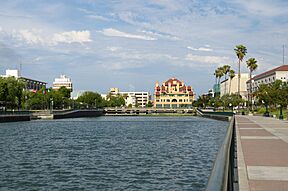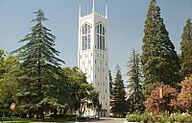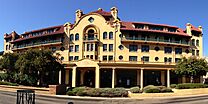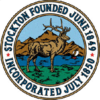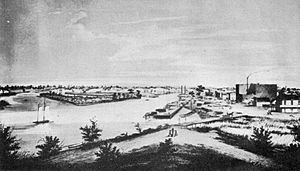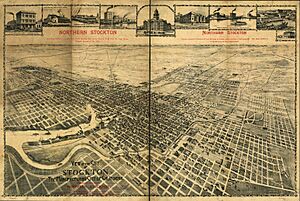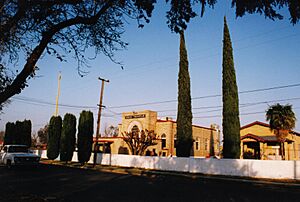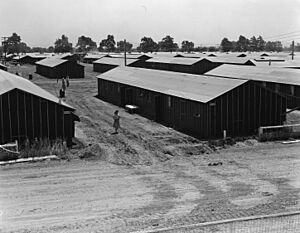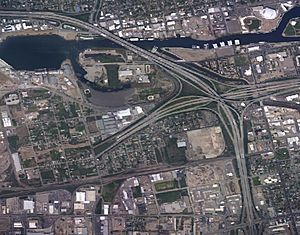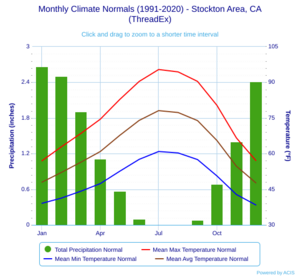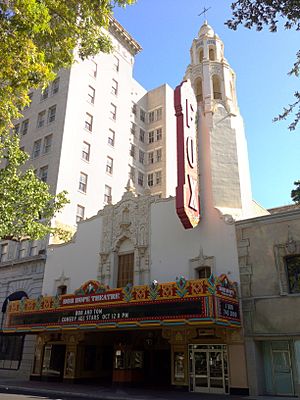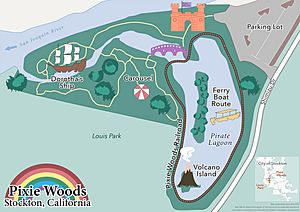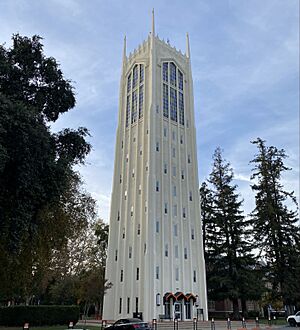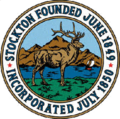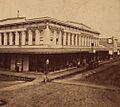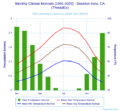Stockton, California facts for kids
Quick facts for kids
Stockton
|
|||
|---|---|---|---|
|
|
|||
|
|||
| Nickname(s):
"Tuleburg", "Mudville", "California's Sunrise Seaport", "Port City", "Asparagus Capital of America".
|
|||
| Motto(s):
"Stockton: All American City"
|
|||
| Country | United States | ||
| State | California | ||
| Region | San Joaquin Valley | ||
| County | San Joaquin | ||
| Incorporated | July 23, 1850 | ||
| Named for | Robert F. Stockton | ||
| Government | |||
| • Type | City Manager-Council | ||
| Area | |||
| • City | 65.25 sq mi (169.01 km2) | ||
| • Land | 62.17 sq mi (161.02 km2) | ||
| • Water | 3.08 sq mi (7.99 km2) 4.76% | ||
| Elevation | 13 ft (4 m) | ||
| Population
(2020)
|
|||
| • City | 320,804 | ||
| • Rank | 1st in San Joaquin County 11th in California 60th in the United States |
||
| • Density | 4,916.5/sq mi (1,898.14/km2) | ||
| • Urban | 414,847 (US: 101st) | ||
| • Urban density | 4,486.7/sq mi (1,732.3/km2) | ||
| • Metro | 779,233 (US: 76th) | ||
| Demonym(s) | Stocktonian | ||
| GDP | |||
| • Metro | $32.624 billion (2022) | ||
| Time zone | UTC−8 (Pacific) | ||
| • Summer (DST) | UTC−7 (PDT) | ||
| ZIP Codes |
95201–95213, 95215, 95219, 95267, 95269, 95296–95297
|
||
| Area code | 209 | ||
| FIPS code | 06-75000 | ||
| GNIS feature IDs | 1659872, 2411987 | ||
Stockton is a city in the Central Valley of California. It is the main city in San Joaquin County. With over 320,000 people in 2020, it is the 11th largest city in California. Stockton has won the "All-America City Award" multiple times.
The city is located on the San Joaquin River. It is at the edge of a large river delta. This delta separates Stockton from cities like Sacramento and those in the San Francisco Bay Area.
Charles Maria Weber founded Stockton in 1849. He bought the land known as Rancho Campo de los Franceses. The city is named after Robert F. Stockton. It was the first city in California not named after a Spanish or Native American word.
Stockton's seaport was built during the California Gold Rush. It helped transport goods to the gold mines. The University of the Pacific (UOP) is in Stockton. It is the oldest university in California, started in 1851. In 2012, Stockton faced financial problems and filed for bankruptcy. This was due to past money issues and the 2008 financial crisis. The city successfully recovered from bankruptcy in 2015.
Contents
- History of Stockton
- Geography of Stockton
- Economy and Business
- Climate in Stockton
- People of Stockton
- Arts and Culture in Stockton
- Sports in Stockton
- Parks and Recreation
- Education in Stockton
- Getting Around Stockton
- Media in Stockton
- Famous People from Stockton
- Sister Cities
- Images for kids
- See also
History of Stockton
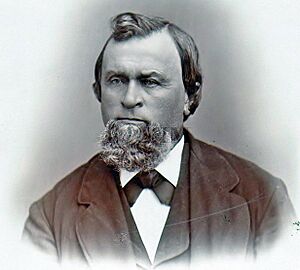
When Europeans first came to the Stockton area, Yokuts Indians lived there. They built their villages on small hills to avoid floods. One village, Pasasimas, was in downtown Stockton.
The Siskiyou Trail started in this area. It was an old Native American path. It led through the Sacramento Valley and into what is now Oregon.
The Miwok Indians used the waterways around Stockton for hundreds of years. During the California Gold Rush, large ships could sail up the San Joaquin River. This made Stockton a key port for miners. From the mid-1800s, Stockton became a center for moving farm products.
Early Days and the Gold Rush
Carlos Maria Weber was born in Germany. He came to the United States in 1836. He later moved to California in 1841. In 1842, Weber settled in San Jose.
Weber could not get land directly because he was not a Mexican citizen. So, he partnered with Guillermo Gulnac. Gulnac was a Mexican citizen and applied for a large land grant. This land was called Rancho Campo de los Franceses.
Weber took over the land in 1845. He encouraged people to settle there. When the Mexican–American War started, Weber joined the United States Cavalry. He moved to the rancho in 1847.
When the California Gold Rush began in 1848, many people came through Weber's land. They were on their way to the goldfields. Weber soon found that selling supplies to gold-seekers was more profitable than mining.
Stockton quickly grew as a supply point for miners. Weber built the first permanent home in the San Joaquin Valley. This spot is now called Weber Point. Stockton became a busy river port. It was a center for roads leading to gold settlements.
In its early years, Stockton had many names. These included "Weberville" and "Mudville." In 1849, Weber planned a town. He first named it "Tuleburg." But he soon chose "Stockton" to honor Commodore Robert F. Stockton. Stockton was the first California community with a name not from Spanish or Native American origins.
Chinese Immigration to Stockton
Thousands of Chinese people came to Stockton in the 1850s. They came from the Guangdong province of China. They were looking for gold and escaping problems in China. After the gold rush, many worked on railroads. They also helped with land projects in the Sacramento–San Joaquin River Delta. Many stayed in Stockton.
By 1880, Stockton had the third-largest Chinese community in California. Laws like the Chinese Exclusion Act of 1882 made it hard for Chinese people to immigrate. These laws also stopped them from buying property. The Lincoln Hotel, built in 1920 by the Wong brothers, was a fine hotel. American-born Chinese were allowed to buy property only after 1962.
City Growth in the 1900s

The city of Stockton officially became a city on July 23, 1850. The first city election was held soon after. Early settlers came from many parts of the world. This included Asia, Africa, Europe, and Mexico. Stockton's diverse history is seen in its street names and festivals.
Benjamin Holt moved to Stockton in 1883. He and his brothers started the Holt Manufacturing Company. In 1904, Holt successfully tested the first working continuous track machine. This machine could plow wet farmland. A company photographer said it "crawled like a caterpillar." Holt liked the name, and that's how the "Caterpillar" tractor got its name!
During World War I, Holt tractors were used by the British and French armies. They helped move heavy guns and supplies.
The first Sikh temple in the United States opened in Stockton. Gurdwara Sahib Stockton was built on October 24, 1912. It was founded by Baba Jawala Singh and Baba Wasakha Singh. They were successful Punjabi farmers.
In 1933, the port was updated. The Stockton Deepwater Channel was made deeper. This helped ships reach the city from San Francisco Bay. This created new business chances and helped the city grow.
During World War II, the Stockton Assembly Center was built. It was at the San Joaquin County Fairgrounds. This center was one of 15 temporary sites. It held about 4,200 Japanese-Americans. They were moved from their homes on the West Coast. They waited here before being sent to larger camps. The center opened on May 10, 1942. It closed on October 17, 1942. Most people were sent to a camp in Arkansas. This site was named a California Historical Landmark in 1980.
In 1996, the Naval Reserve Center on Rough and Ready Island closed. This base was important during the Cold War. It is now being used for businesses.
Geography of Stockton
Stockton is in the San Joaquin Valley of California. This area is known for its farmland. Around Stockton, there are thousands of miles of waterways. These make up the California Delta.
Major highways like Interstate 5 and State Route 99 go through Stockton. These are important roads for travel in California. State Route 4 connects Stockton to the San Francisco Bay Area. The deepened San Joaquin River also links Stockton to the Bay. This creates the Stockton Deepwater Shipping Channel. Stockton and Sacramento are California's only inland seaports.
The city covers about 64.8 square miles. About 3.1 square miles of this area is water.
Economy and Business
Stockton was once mainly a farming community. Now, its economy includes other industries. These include telecommunications and manufacturing.
Stockton's location is good for businesses. It is close to San Francisco and Sacramento. It also has easy access to highways. Land costs are also lower here. Because of this, many companies have set up their regional offices in Stockton.
Shopping in Stockton
Stockton has one main shopping mall, the Weberstown Mall. There was also the Sherwood Mall, but it became a shopping center called Sherwood Place in 2022.
City Finances and Recovery
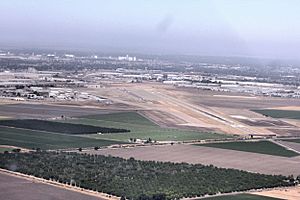
In the late 1990s, Stockton started projects to improve the city.
The housing market in Stockton was hit hard by the 2007 subprime mortgage financial crisis. In 2007, Stockton had the most foreclosures in the United States. This meant many homes were taken by banks. Between 2006 and 2007, the value of homes in Stockton dropped by 44%.
In June 2012, Stockton became the largest city in U.S. history to file for bankruptcy protection. This was due to the housing market crash. The city's income from taxes dropped a lot. In October 2013, the city council approved a plan to exit bankruptcy. Voters also approved a sales tax to help fund the recovery.
On October 30, 2014, a judge approved the city's plan. Stockton officially exited bankruptcy on February 25, 2015.
Guaranteed Basic Income Experiment
In 2019, Stockton started a special project. It was called the Stockton Economic Empowerment Demonstration (S.E.E.D.). This project gave $500 each month to 125 randomly chosen residents. They received the money for 24 months with "no strings attached." This means they could spend it however they needed. The project was funded by private groups. A report in March 2021 showed positive results from the program.
Climate in Stockton
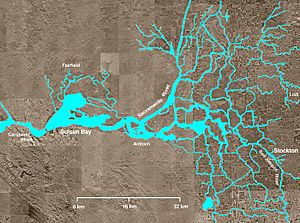
Stockton has a climate that changes between hot, dry summers and cool, wet winters. Most of the rain falls from October to April. Because it's in the Central Valley, temperatures change more than in the nearby Bay Area.
Tule fog can cover the area on some winter days. Stockton is in a fertile delta area. It is about halfway between the Pacific Ocean and the Sierra Nevada mountains.
The highest temperature ever recorded was 115°F (46°C). This happened on July 23, 2006, and September 6, 2022. The lowest was 16°F (-9°C) on January 11, 1949. On average, there are 88 days a year with temperatures of 90°F (32°C) or higher. About 19 days reach 100°F (38°C) or more. There are also about 19 mornings with freezing temperatures.
The most rain in one year was 27.89 inches (708 mm) from July 1982 to June 1983. The driest year had only 5.71 inches (145 mm). Stockton usually has about 56.5 days with some rain. Snowfall is very rare. Only a small amount of snow was measured on February 5, 1976.
A study in 2018 warned about possible flooding from the San Joaquin River. It said that parts of Stockton could be underwater if the levees are not improved.
| Climate data for Stockton Metropolitan Airport, California (1991–2020 normals, extremes 1948–present) | |||||||||||||
|---|---|---|---|---|---|---|---|---|---|---|---|---|---|
| Month | Jan | Feb | Mar | Apr | May | Jun | Jul | Aug | Sep | Oct | Nov | Dec | Year |
| Record high °F (°C) | 78 (26) |
79 (26) |
87 (31) |
100 (38) |
107 (42) |
111 (44) |
115 (46) |
113 (45) |
115 (46) |
105 (41) |
85 (29) |
76 (24) |
115 (46) |
| Mean maximum °F (°C) | 65.3 (18.5) |
71.6 (22.0) |
79.3 (26.3) |
89.3 (31.8) |
97.3 (36.3) |
104.3 (40.2) |
105.8 (41.0) |
104.9 (40.5) |
101.4 (38.6) |
92.2 (33.4) |
77.8 (25.4) |
65.9 (18.8) |
107.7 (42.1) |
| Mean daily maximum °F (°C) | 57.0 (13.9) |
62.9 (17.2) |
68.5 (20.3) |
74.5 (23.6) |
82.8 (28.2) |
90.4 (32.4) |
95.4 (35.2) |
94.4 (34.7) |
90.4 (32.4) |
80.3 (26.8) |
66.6 (19.2) |
57.1 (13.9) |
76.7 (24.8) |
| Daily mean °F (°C) | 48.0 (8.9) |
52.1 (11.2) |
56.4 (13.6) |
60.9 (16.1) |
67.7 (19.8) |
74.0 (23.3) |
78.1 (25.6) |
77.3 (25.2) |
73.9 (23.3) |
65.5 (18.6) |
54.7 (12.6) |
47.7 (8.7) |
63.0 (17.2) |
| Mean daily minimum °F (°C) | 39.1 (3.9) |
41.3 (5.2) |
44.2 (6.8) |
47.4 (8.6) |
52.6 (11.4) |
57.6 (14.2) |
60.9 (16.1) |
60.3 (15.7) |
57.5 (14.2) |
50.6 (10.3) |
42.8 (6.0) |
38.4 (3.6) |
49.4 (9.7) |
| Mean minimum °F (°C) | 28.2 (−2.1) |
31.0 (−0.6) |
35.0 (1.7) |
38.3 (3.5) |
44.5 (6.9) |
49.8 (9.9) |
54.1 (12.3) |
53.8 (12.1) |
49.9 (9.9) |
41.0 (5.0) |
31.9 (−0.1) |
27.9 (−2.3) |
26.0 (−3.3) |
| Record low °F (°C) | 16 (−9) |
13 (−11) |
20 (−7) |
27 (−3) |
29 (−2) |
35 (2) |
38 (3) |
37 (3) |
32 (0) |
26 (−3) |
23 (−5) |
15 (−9) |
13 (−11) |
| Average precipitation inches (mm) | 3.27 (83) |
2.80 (71) |
2.31 (59) |
1.11 (28) |
0.57 (14) |
0.10 (2.5) |
0.00 (0.00) |
0.01 (0.25) |
0.08 (2.0) |
0.69 (18) |
1.05 (27) |
2.81 (71) |
14.8 (375.75) |
| Average precipitation days (≥ 0.01 in) | 9.7 | 9.2 | 9.0 | 5.3 | 2.9 | 1.0 | 0.2 | 0.2 | 0.7 | 2.8 | 6.4 | 9.1 | 56.5 |
| Average relative humidity (%) | 83.6 | 78.1 | 69.5 | 61.4 | 52.9 | 48.6 | 46.4 | 48.2 | 52.0 | 59.8 | 75.5 | 83.6 | 63.3 |
| Average dew point °F (°C) | 39.6 (4.2) |
42.3 (5.7) |
42.1 (5.6) |
42.3 (5.7) |
45.7 (7.6) |
48.9 (9.4) |
51.8 (11.0) |
52.0 (11.1) |
50.5 (10.3) |
46.9 (8.3) |
43.9 (6.6) |
39.2 (4.0) |
45.4 (7.5) |
| Source: NOAA (dew points and relative humidity 1961–1990) | |||||||||||||
People of Stockton
| Historical population | |||
|---|---|---|---|
| Census | Pop. | %± | |
| 1860 | 3,679 | — | |
| 1870 | 10,066 | 173.6% | |
| 1880 | 10,282 | 2.1% | |
| 1890 | 14,424 | 40.3% | |
| 1900 | 17,506 | 21.4% | |
| 1910 | 23,253 | 32.8% | |
| 1920 | 40,296 | 73.3% | |
| 1930 | 47,963 | 19.0% | |
| 1940 | 54,714 | 14.1% | |
| 1950 | 70,853 | 29.5% | |
| 1960 | 86,321 | 21.8% | |
| 1970 | 109,963 | 27.4% | |
| 1980 | 148,283 | 34.8% | |
| 1990 | 210,943 | 42.3% | |
| 2000 | 243,771 | 15.6% | |
| 2010 | 291,707 | 19.7% | |
| 2020 | 320,804 | 10.0% | |
| U.S. Decennial Census 2020 | |||
Stockton is a very diverse city. In 2020, U.S. News & World Report called Stockton America's most diverse city.
The city's population has grown a lot over the years. In 2010, Stockton had 291,707 people. About 40.3% of the people were Hispanic or Latino. About 21.5% were Asian.
Top Employers in Stockton
The biggest employers in Stockton include:
- Stockton Unified School District (schools)
- Amazon (online retail)
- St. Joseph's Medical Center (hospital)
- San Joaquin County Office of Education (education)
- City of Stockton (city government)
- University of the Pacific (university)
- Pacific Gas and Electric (energy company)
- Lincoln Unified School District (schools)
- Kaiser Permanente (healthcare)
- San Joaquin Delta College (college)
Arts and Culture in Stockton
Performing Arts
Music in Stockton
- The Stockton Symphony is California's third-oldest professional orchestra. It started in 1926.
- The University of the Pacific has a great music school. It is home to the Brubeck Institute. This institute is named after jazz legend Dave Brubeck.
- San Joaquin Delta College also has a growing jazz program.
- The Stockton Arena hosts many concerts. Famous artists like Gwen Stefani and Bob Dylan have performed there.
- The annual Apollo Night show features talented musicians from Northern California.
Theatre in Stockton
The Bob Hope Theatre in downtown Stockton is a beautiful old movie palace. It was built in 1930. The famous entertainer Bob Hope often visited Stockton. He was friends with billionaire Alex Spanos. Spanos helped pay to fix up the theater after Hope passed away.
The University of the Pacific and San Joaquin Delta College also have places for performances. The Stockton Civic Theatre has been putting on plays since 1951. They perform musicals, comedies, and dramas.
Visual Arts and Museums
Stockton has several interesting museums:
- The Haggin Museum shows 19th and 20th-century art. It also has exhibits about local and California history.
- The San Joaquin County Historical Society and Museum is on 18 acres. It tells the story of Stockton's founding. It also shows how farming and manufacturing grew in the county.
- The Children's Museum of Stockton is in a former warehouse. It has many hands-on exhibits for kids.
- The National Pinoy Museum opened in 2015. It is in the Little Manila area. It tells the history of Filipino Americans. Stockton has one of the largest Filipino populations in the U.S.
- The Stockton Field Aviation Museum has items from the WWII era.
- The Mexican Heritage Center & Gallery promotes Mexican art and culture.
Many downtown buildings have Murals showing the city's history. Stockton is also known as "Tree City USA." It has over 77,000 trees!
Stockton has more than 275 restaurants. You can find many types of food. This shows the city's diverse culture.
Festivals and Celebrations
Stockton hosts many yearly festivals. They celebrate the city's different cultures.
- San Joaquin Children's Film Festival
- Chinese New Year's Parade and Festival (March)
- Stockton Asparagus Festival (April)
- Brubeck Jazz Festival (April)
- Cambodian New Year (April)
- Annual Nagar Kirtan, Sikh parade (April)
- Stockton Flavor Fest (May)
- Cinco de Mayo Parade and Festival (May)
- Jewish Food Fair (June)
- Juneteenth Day Celebration (June)
- Stockton Obon Bazaar (July)
- Filipino Barrio Fiesta (August)
- Stockton Pride (August)
- Greek Festival (September)
- Festa Italiana: Tutti In Piazza (September)
- Dia De Los Muertos Festival (October)
- Hmong New Year (November)
- Stockton Festival of Lights and Boat Parade (December)
Sports in Stockton
Stockton is home to two professional minor league sports teams:
- Stockton Kings—a NBA G League basketball team. They are linked with the Sacramento Kings.
- Stockton Ports—a Low-A West baseball team. They are linked with the Athletics.
The Stockton Ports baseball team plays at Banner Island Ballpark. This stadium can hold 5,000 fans. The Ports have been a baseball team in Stockton since 1946. They have won eleven championships. Many Ports players have gone on to play in Major League Baseball.
The Stockton Arena is a 10,000-seat arena. It opened in 2005. It is home to the Stockton Kings basketball team.
Stockton has the oldest NASCAR-certified race track west of the Mississippi River. The Stockton 99 Speedway opened in 1947. It is a quarter-mile oval track. It can hold 5,000 fans.
Stockton also has many youth sports leagues. These include Little League Baseball and softball leagues. The University of the Pacific hosts a rowing competition each year.
You can find many sports activities in Stockton. There are golf courses, and places for rowing, sailing, and fishing. Stockton is also home to UFC fighters Nick and Nate Diaz. They teach Brazilian jiu-jitsu to kids and teens in Stockton.
Parks and Recreation
Stockton has a fun children's amusement park called Pixie Woods. It opened in 1954. Over one million visitors have enjoyed the park since then.
Education in Stockton
Schools for Kids and Teens
Stockton has several public school districts. These include Stockton Unified School District and Lincoln Unified School District. There are also more than 40 private schools. Saint Mary's High School is one of them. Stockton also has public charter schools.
Colleges and Universities
The University of the Pacific moved to Stockton in 1923. It is a private university. It offers many different degree programs. The men's Pacific Tigers basketball team has played in the NCAA Tournament many times. The campus has been used to film Hollywood movies. This is partly because it looks like older universities on the East Coast.
Other colleges in Stockton include:
- San Joaquin Delta College: This college serves San Joaquin County and nearby areas.
- California State University, Stanislaus has a campus in Stockton.
- Humphreys University: A private school offering degrees, including law.
- Christian Life College: A private Bible college.
Getting Around Stockton
Stockton is easy to get to. It has access to:
- The Port of Stockton—an international deep-water port.
- The Amtrak train system.
- Major highways.
- Stockton Metropolitan Airport.
Roads and Trains
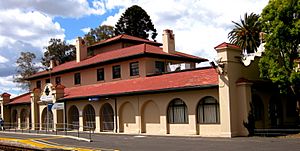
Stockton is at a "crossroads" in the Central Valley. Highways like Interstate 5 and State Route 99 go through the city. State Route 4 connects Stockton to the San Francisco Bay Area.
Stockton has two train stations for passengers. The Robert J. Cabral Station offers service to Sacramento. It is also the start of the Altamont Corridor Express train to San Jose. The San Joaquin Street station offers service to Oakland.
Large railroad companies like Union Pacific and BNSF Railway serve Stockton. They connect to the port.
Air Travel
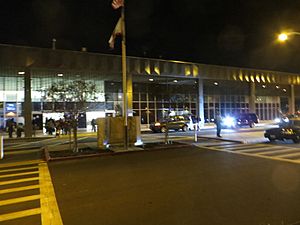
Stockton Metropolitan Airport is just south of the city. It is used by manufacturing and farming companies for shipping. Passenger flights started again in 2006. Allegiant Air offers flights to Las Vegas and Phoenix.
Seaport
The Port of Stockton is a busy seaport. It is about 75 miles (139 km) east of the Golden Gate Bridge. It is on the San Joaquin River. The port has space for 17 large ships. As of 2014, the Port of Stockton had 136 businesses. It is served by two major railroads.
Next to the port is Rough and Ready Island. This was a naval supply base during World War II. It closed in 1995. Now, it is being used for businesses.
Media in Stockton
Newspapers and Magazines
- The Record is a daily newspaper.
- Stocktonia News Service is an online news site.
- Bilingual Weekly News publishes a newspaper in Spanish and English.
- San Joaquin Magazine covers lifestyle in Stockton and nearby cities.
Radio Stations
Stockton has several AM and FM radio stations. You can also hear stations from nearby Sacramento and Modesto.
AM Stations
- KCVR 1570: Spanish Adult Hits
- KWG 1230: Catholic, News/Talk. It is one of California's oldest AM radio stations.
- KWSX 1280: Rock and Roll
- KSTN 1420: Modern Country
FM Stations
- KQED-FM 88.5: News/Talk (NPR)
- KLOVE 89.7: Christian
- KUOP 91.3: News/Talk and Jazz (NPR)
- KHOP 95.1: Top 40
- KWIN 97.7: Urban Contemporary
- KJOY 99.3: Lite Rock
- KATM 103.3: Country
- KSTN 105.9: Modern Country
- KLVS 107.3: Christian
Television Stations
Stockton is part of the Sacramento-Stockton-Modesto TV market. It gets stations from Sacramento and some from the San Francisco Bay Area.
- KCRA Channel 3 (NBC affiliate) Sacramento
- KRON Channel 4 (The CW station) San Francisco
- KVIE Channel 6 (PBS station) Sacramento
- KOVR Channel 13 (CBS station) Stockton
- KUVS Channel 19 (Univision station) Modesto
- KTXL Channel 40 (Fox affiliate) Sacramento
- KTNC Channel 42 (Tri-State Christian Television station) Concord
- KTFK-DT Channel 64 (UniMás station) Stockton
Famous People from Stockton
Many notable people are from Stockton. Reagan Maui'a, a former NFL football player, grew up here. Jose M. Hernandez, a NASA astronaut, calls Stockton his hometown. Chi Cheng, former bass player for the Deftones, was born and raised in Stockton. Musician Chris Isaak was also born here. The indie rock band Pavement started in Stockton in 1989. Nick and Nate Diaz, famous mixed martial arts fighters, are from the Stockton area. The acclaimed author Maxine Hong Kingston was born in Stockton in 1940. A school, the Maxine Hong Kingston Elementary School, is named after her.
Sister Cities
Stockton has seven sister cities around the world:
| Country | City | Year of Partnership |
|---|---|---|
| Shizuoka | 1959 | |
| Iloilo City | 1965 | |
| Empalme | 1973 | |
| Foshan | 1988 | |
| Parma | 1998 | |
| Battambang | 2004 | |
| Asaba | 2006 |
Images for kids
-
Benjamin Holt (left) with British Col. Ernest Dunlop Swinton in Stockton, April 1918. The vehicle on the right is a Holt tractor; on the left is a miniature replica of a British tank.
-
View across Stockton Metropolitan Airport, 2009
-
Stockton in relation to the Sacramento–San Joaquin River Delta
-
The San Joaquin Street Amtrak station in Stockton
-
Passenger terminal of Stockton Metropolitan Airport
See also
 In Spanish: Stockton (California) para niños
In Spanish: Stockton (California) para niños


